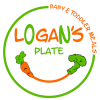When to start weaning, BLW vs Spoon Feeding, which foods to give and when, are the main questions every parent has. If you put any of those questions into Google, you are hit with pages and pages of information (some even incorrect).
It can be very daunting. I know it was for me at first, but after doing many months of research when pregnant with Logan, I was armed and ready. I’m also incredibly headstrong so once I have set my mind to something, it takes a lot to sway me.
Looking at the advice from the likes of NHS, leading childhood nutritionists and First Steps Nutrition, I chose to do a combination of BLW and Spoon Fed purees. Read about my weaning experience here.
In this blog post I cover when to begin weaning and break down the perceived pros & drawbacks of both BLW and Spoon Fed.
When to start weaning
It is advised that you begin weaning when your little one is around the 6 months mark. Up until then breast milk and/or formula provide babies with everything they need. Waiting until 6 months allows babies and their guts to develop enough to handle solid foods.
I’m always asked, “well, how will I know they are ready?”
There are signs:
- They are able to sit unaided and support their head. This is so important.
- They are able to pick up objects and bring them to their mouths.
- They’ll start to show interest in food. If it starts to become hard to eat in front of them, they meet the milestones and are age appropriate, get them their own plate!
Always seek/follow the advice of your healthcare provider about when to start weaning or for any concerns you have.
A weaning workshop run by qualified childhood nutritionists is a fantastic way to get all your questions answered in one go.
BLW vs Spoon Feeding
Ahh, the million pound question. I’d love to be able to steer you in the direction of one option with strong conviction. But, it’s not really that simple. Each method of weaning brings it’s own positives and I wouldn’t use the word negatives, but there are drawbacks.
As mentioned above I chose to do a combination of both BLW with finger foods and purees with a spoon. I wanted to take advantage of the benefits of both.
BLW
Baby led weaning or BLW, is the process of weaning when you allow a child to feed themselves with appropriate finger foods.
Pros:
- It is said that little ones weaned with BLW are less likely to grow up fussy, have more adventurous palates and make more informed food choices. They are still likely have a picky phase, though, not sure any of us are safe from that.
- They’re used to lumps and textures from the beginning. Some babies weaned on purees alone can struggle when introduced to more lumpy textures.
- Helps with hand-eye coordination and cause and effect.
- It’s a lot quicker to prepare meals. No need to spend time mashing or pureeing.
- Family meal times continue as usual. Eating some of the same foods as the family during meals and observing what you do with food, only encourages them to mimic the same behaviours.
Drawbacks:
- The mess. Weaning is messy regardless of how you do it, but arming your child with a selection of food they can throw – it’s going to get messy.
- Time. It can take a while for your little to explore all the delights in front of them. They shouldn’t be rushed, meal times should be relaxed and enjoyable.
- Knowing how much they’ve actually eaten can be a worry. A lot of the food will be squished, rubbed, dropped and thrown, so knowing exactly how much they’ve consumed can be tough to work out.
SPOON FEEDING
Spoon feeding or traditional weaning, is the process of weaning, where you serve soft mashed or pureed food via a spoon. As your child gets used to solids, you begin to introduce more textured foods and eventually foods in their full form.
Pros:
- The actual meal time is quicker. You and your little one are in control of how quickly they get the food on the spoon.
- Less mess. You’re in control of the spoon – in most cases. If like me, your little one decides they want to use the spoon, it can lead to a messy time.
- You know how much food your little one has eaten.
Drawbacks:
- Takes more time to prepare meals.
- It is said that some babies weaned on purees alone can struggle with being introduced to more textured food. I didn’t experience this with Logan.
- Usually babies are fed before or after everyone else, so they are not part of family meal times.
How you choose to wean is your decision. Whichever method you choose, should be done safely and with advice from your healthcare provider or qualified weaning expert if needed.
All tips/opinions in this blog post have be written from my own experience and after working closely with weaning experts. If you have any questions or concerns, contact your healthcare provider immediately.
Tijani x


